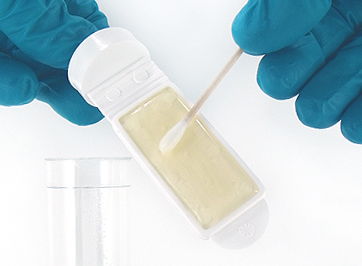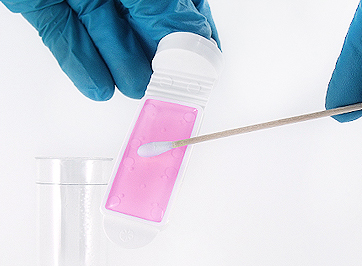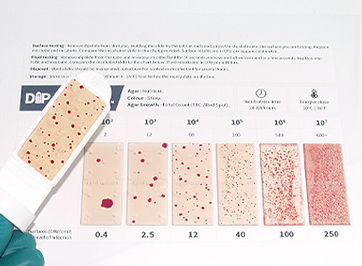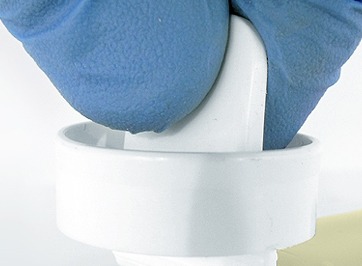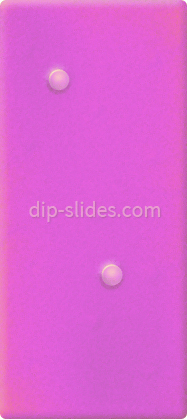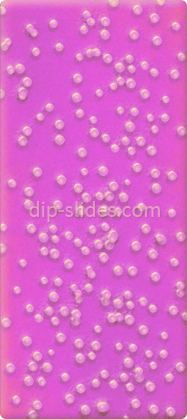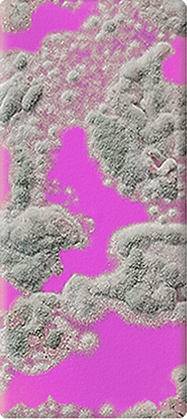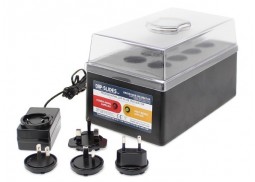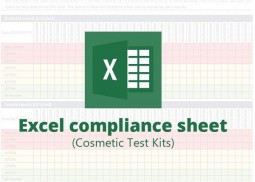Our cosmetics dipslides (CRBS) can be dipped into your cosmetics sample or your sample can be swabbed onto the dipslide. These dipslides feature two different agars (culture media). If your cosmetic sample contains bacteria, yeasts or moulds, colonies will grow on the dipslide agar. The CRBS cosmetics dipslides have TSA agar on one side and Rose Bengal agar on the other side. The CRBS dipslide paddle is contained in a sterile gamma irradiated tube. The TSA agar tests for / grows a total bacteria count (TVC). The Rose Bengal agar tests for / grows a yeasts and moulds (fungi) count.
Contaminated cosmetics can become harmful to the user if levels of bacteria / fungi are high. It can also cause spoilage to the cosmetic, causing changes in smell and appearance.
Lotions / emulsions, shampoos and conditioners contain water unlike other cosmetics such as eye shadow and powders. This means that lotions etc are more likely to contain contaminants as water promotes microbial growth.
If certain scenarios such as someone using a contaminated product on broken skin or around the eyes occur, the user may develop an infection.
The FDA states the following on their website:
"Companies and individuals who manufacture or distribute cosmetics are legally responsible for the safety of their products. This includes, for example, making sure cosmetics are free of harmful microorganisms".
Further information can be found here: http://www.fda.gov/Cosmetics/ProductsIngredients/PotentialContaminants/ucm433748.htm
The Guidelines from the Scientific Committee on Consumer Safety (European Commission) recommend that cosmetic products for children under 3 or for use around the eyes should not have a cfu/ml of more than 102cfu/ ml (total viable count). Any other cosmetic products should not exceed 103 cfu/ml. More information can be found here: SCCP Guidelines.
Our full colour comparison sheet will help you to assess the cfu/ml in your sample. Scroll down to 'Reading The Results' to view the chart.
Making sure to wear sterile gloves, open the pouch and take out the swab
The swab end should only come into contact with the sample as to reduce a chance of cross contamination.
Carefully streak the sample onto one side of the dipslide then dispose of the swab.
Repeat the procedure using a new swab (do not use the same swab) and streak on the Rose Bengal (pink) side.
Incubate the dipslide for 24 - 120 hours. Growth will show on the 'total count' side (straw coloured) side within 24-48 hours.
Compare the dipslide against the comparison chart and record the amount of growth.
Cosmetic Dipslide Features
Each dipslide features a virtually unbreakable and flexible paddle allowing for even, full surface testing.
Due to the design of the dipslide, fluids will drain off quickly during testing.
Each slide has a handle built into the lid that is recessed to help keep your fingers dry during testing.
One side of the slide will have a circle indicator so you know which side was used for testing which type of contaminant.
Each dipslide is dual sided to allow multiple contamination testing with one test.
Each agar is thick (approx 4mm) and raised above the dipslide to allow for easy surface testing.
With viscous lotions, it is advisable to use a swab to transfer the sample onto the dipslide rather than dipping the slide in the sample itself.
- Unscrew the lid from the dipslide, take a swab from your sample and apply it to one side of the dipslide.
- Repeat the procedure on the other side of the dipslide.
- Replace the lid and place the slide in an incubator for 24 - 120 hours. Growth will show on the 'Total Count' side within 24-48 hours. Growth on the yeasts / moulds side will take longer (up to 120 hours).
- Once incubated, compare results with the chart provided.
In order to test your samples, you will need an incubator. We offer a full range of incubators of various sizes. Our Gnat incubator which holds two slides at a time is very popular for smaller applications.
Sterile swabs can be purchased here: Individually wrapped swabs.
What is a Cosmetic Dipslide?
The Cosmetic dipslide is a dual sided slide coated in two different agars. It features a Tryptone Soya Agar with TTC to detect aerobic bacteria and a Rose Bengal Agar to detect yeasts and moulds. It is used in the cosmetic industry to monitor microbiological contamination in creams and liquids (CFU/ml).
Reading the results / Guidelines
Customer Questions
|
Q
|
Hi, I am wanting a microbial test kit for natural skin care. Do these cosmetic dip slides do both bacterial and yeasts and moulds? What is the life span of the dip slides? Could you also let me know the cost of shipping to New Zealand.
|
|
A
|
Hello, Yes, these dipslides test for bacteria (total count with red spot dye) on one side and yeasts and moulds on the other. The expiry date of the current batch is shown under the buy now button. Shipping is calculated during the checkout once an address is provided.
|
|
Q
|
Hello, Do these show the current bacteria, yeast and mold present in your products or do the test accelrate the growth process.
|
|
A
|
Hello, The slides show the current bacteria, yeast and mould present in the sample at the time of testing.
|
|
Q
|
Do these kits contain animal extracts? I understand the nutrient is usually meat extract and wish to avoid this.
Thanks
|
|
A
|
Hello, All agars contain gelatin. All ingredients are listed in the datasheets available at the bottom of the page.
|
|
Q
|
Can you keep the test for longer than the recommended 120 hours if you are trying to determine the shelf life of your products?
|
|
A
|
Hello, Yes, you can incubate the slides for a longer time if required.
|
|
Q
|
Sorry, I have another question. I recently opened a small online body care business. I want to make sure that my products are free from bacteria and mold, as I don't use artificial preservatives in my products. Unfortunately, I am a new business and don't have enough money for the incubator only the slides. I know the incubator keeps the slide at a constant temperature. If the slides are not maintained at a consistent temperature will the results be accurate? I live in a very warm climate, If condensation builds up in the tubes will this affect the accuracy of the test?
|
|
A
|
Hello, Dipslides need a constant temperature for the results to be accurate. As such, we do not recommend using dipslides without an incubator as the reading may be incorrect (e.g. not all the bacteria / mould could have grown / be visible). Condensation is normal in the tubes as this is the moisture evaporating from the agar.
|
|
Q
|
So is this a test kit to find bacteria on old makeup? Can you do it all at home?
|
|
A
|
Hello, This is generally purchased by manufacturers or small businesses that wish to test their make up to check if contamination has occurred during manufacturing. It can be used at home should you wish to test your own make up. Please note, an incubator would be required which can either be purchased separately or as part of the kit at https://dip-slides.com/kits/83-cosmetics-bacteria-yeasts-moulds-test-kit.html.
|
|
Q
|
Hello, I am starting a natural/organic skin line can you recommend a product i can use to test for mould and bacteria? to ensure my preservatives are working well?
I plan to test my facial creams each month for 6 months we are hoping we can meet a product expiry date of 6 months.
Local skin care companies suggest testing for the below contaminants:
Enterobacteriaceae: These are a family of gram-negative bacteria that include salmonella and E Coli, neither of which are permitted within cosmetic products.
Brasiliensis: This is the new name for Aspergillus Niger. It is the traditional black mould fungus that you may have seen on cosmetic jar products before.
Albicans: Candida Albicans is a fungus that is usually found on the skin and as such is quite a common contaminant in cosmetics.
Aeruginosa: This is another gram-negative bacteria and one that is found living on our skin as well as in the soil and on many solid surfaces.
Aureus: This is sometimes called Golden Staph.
|
|
A
|
Hello, We usually recommend our cosmetic dipslides. These feature TSA and Rose Bengal Agar. TSA promotes the growth of a wide range of micro-organisms. Organisms such as Staphylococcus aureus and Pseudomonas aeruginosa can grow on this agar. However, the agar is not selective so although the colonies growing may be S.aureus, the agar is for total count applications and there would be no way to distinguish which colonies are a specific micro-organism. You would know whether it is contaminated and how contaminated it is but no specifics. Rose Bengal agar is a yeasts and moulds agar. It will promote growth of a variety of mould / yeast species including Aspergillus niger but again, like TSA is not a selective agar and is designed to show you the total mould / yeasts contamination in your sample.
We do have some selective dipslides for the micro-organisms that you mention, these are linked below: Enterobacteriaceae and staphylococcus: https://dip-slides.com/home/10-baird-parker-violet-red-bile-glucose-vrbg-dipslides-box-of-10.html
Pseudomonas and coliforms: https://dip-slidescom/home/15-pseudomonas-macconkey-3-dipslides-box-of-10.html Hope this helps. Please contact us if you have further questions.
|
|
Q
|
Are these testers accepted for GMP Manufacturer use as reliable testing result?
|
|
A
|
Hello, Dip slides do not fall under any of the categories for which GMP is normally expected and we are not registered as such. You would need to contact your local regulator to check if DipSlides would qualify for this (as this could vary depending on country location).
|
|
Q
|
Hi, can we use these slides for shampoo as well as normal tap water and at which temperature shall it be incubated. Is it easy to deliver to jordan samples for testing purposes.
We shall need huge quantities to test according to GMP
|
|
A
|
Hello, Thank you for contacting us. Can you please e-mail us what your detection requirements so we can confirm which dipslide would be best suited for your application?
|
|
Q
|
Does this product use adenosine triphosphate as the active testing agent?
|
|
A
|
No, CRBS dipslides do not contain adenosine triphosphate.
|
Additional Details
Product Reference : CRBS
Internal catalogue reference : DS001-35
Downloads
 (436.23KB)
(436.23KB)
 (1.89MB)
(1.89MB)







 Verified Customer
Verified Customer
 Verified Customer
Verified Customer
 Verified Customer
Verified Customer
 Verified Customer
Verified Customer
 Verified Customer
Verified Customer
 Verified Customer
Verified Customer
 Verified Customer
Verified Customer
 Verified Customer
Verified Customer
 Verified Customer
Verified Customer
 Verified Customer
Verified Customer
 Verified Customer
Verified Customer
 Verified Customer
Verified Customer
 Verified Customer
Verified Customer
 Verified Customer
Verified Customer
 Verified Customer
Verified Customer
 Verified Customer
Verified Customer
 Verified Customer
Verified Customer
 Verified Customer
Verified Customer





